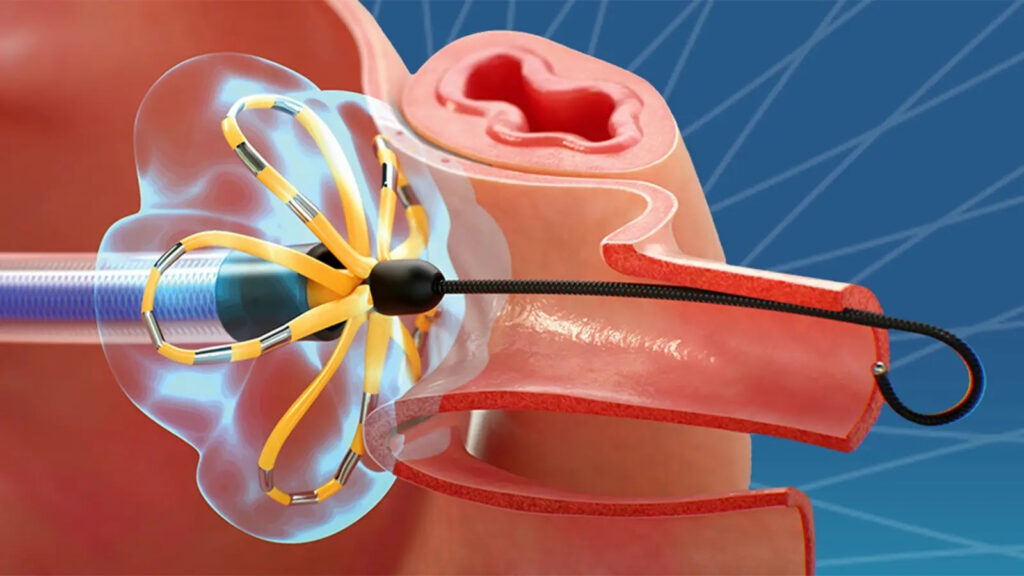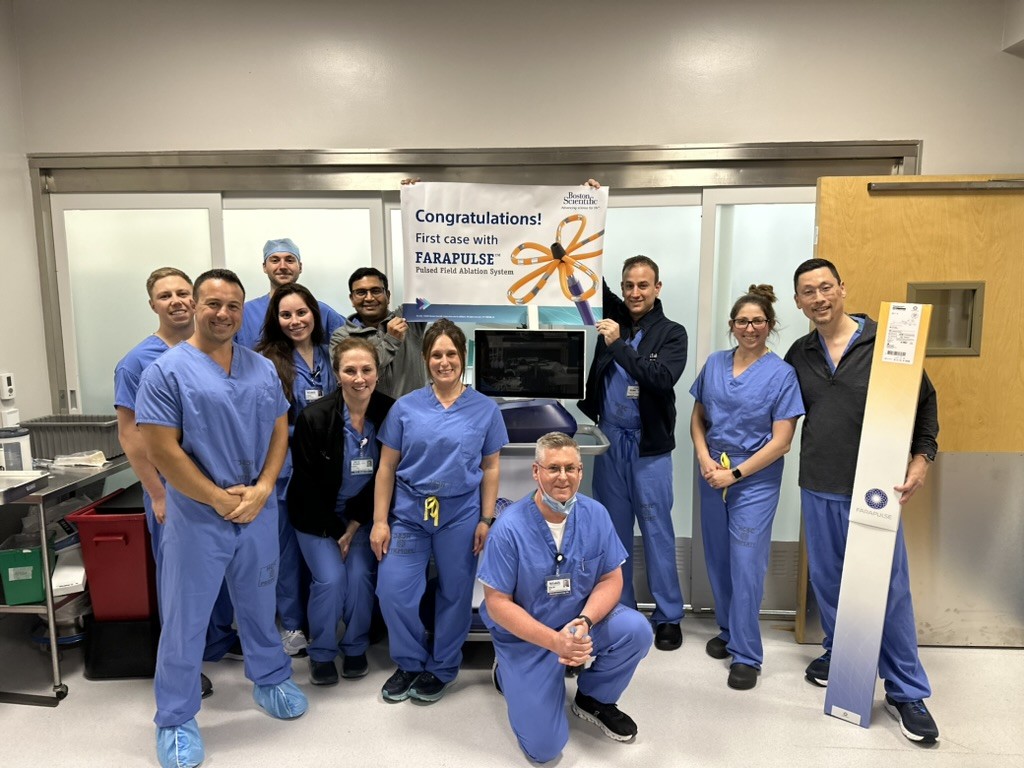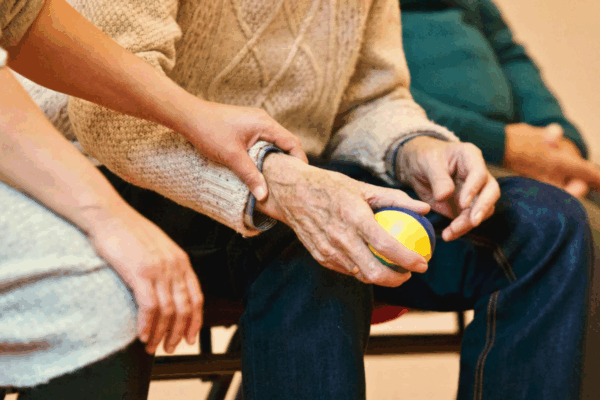The mere thought of overseeing more than 20 kindergartners would make most people’s heart beat faster. But atrial fibrillation (AFib)—irregular and extremely fast heartbeats—was the cause of Bangor School District teacher Rae Temples’ racing heart.
“I always equated the feeling of AFib to someone running a marathon in my chest,” Temples said. “As you’re trying to teach, your heart is racing. Then it suddenly drops, and you have no energy. You feel terrible.”
Due to pulsed field ablation (PFA), a revolutionary new method to treat AFib, Temples looks forward to the new year, knowing the discomfort of a racing heart will no longer burden her. Electrophysiologist Steven Stevens, MD, performed the PFA procedure at St. Luke’s University Hospital-Bethlehem.
“I’ve been an electrophysiologist attending for 10 years now, and I’ve seen the field evolve so fast,” said Dr. Stevens. “It seems like what we were doing before was crawling, but now we’re running. I’m so excited for the next 10 years because it will keep advancing. It’s getting safer and better for patients, and that makes my career a lot more gratifying.”
Dr. Stevens, St. Luke’s electrophysiologists Hardik Mangrolia, MD, Sudip 2, MD, Kevin Mills, MD, and Darren Traub, DO, perform the procedures. Electrophysiologists are cardiologists who have completed additional education—a fellowship—in the heart’s electrical system. They specialize in diagnosing and treating the heart’s rhythm.
The goal of the PFA procedure is to isolate the areas of the heart’s left atrium responsible for atrial fibrillation, which causes irregular heartbeats. During the procedure, the patient is completely asleep and breathing on a ventilator. The physician makes an incision in the groin, enters the heart through the femoral vein, and sends high-voltage pulses to the left atrium to create scarring.
“The scar region prevents erratic signals from reaching the left atrium and starting atrial fibrillation,” Dr. Mangrolia said. “It’s called pulmonary vein isolation. We want to isolate these veins in the left atrium electrically.”
“Think of the heart cells like a house,” he said. “We’re blasting it with high voltage and destroying the inner electrical circuitry without damaging too much of the heart cells’ internal structure.”

After the procedure, the patient remains on bed rest for two to four hours and either stays overnight or goes home the same day. Unlike traditional ablation procedures, there is little charring, and because the procedure affects a broad region in a short amount of time, the procedure time is shorter. Compared with other ablation procedures, patients feel better soon, with the AFib going away. They also have fewer complications.
Traditional ablation procedures scar the region by either burning or freezing the area of the heart that caused the erratic rhythm. About 1% of these traditional procedures are associated with complications. Patients typically feel worse for two to three days after the procedure before they feel better.
“PFA targets the problem without the risk of injuring anything else, so I’m sending patients home the same day,” Dr. Stevens said. “It takes away the onus of scary complications. Since this came out in May, I’ve yet to see a complication. You do the (PFA) ablation and they go home happy. It’s made my job less stressful. I’ve never seen anything quite like this that has changed my career so quickly.”
Before her PFA treatment, Temples had a cryoablation. She experienced pain around her heart, and the arrhythmia, while better, continued. When Dr. Stevens suggested the new procedure, she was reluctant.
“I wanted to be like a kindergartner and dig my heels in and say I don’t want to do that,” she said. Dr. Stevens persuaded her, and she is glad he did. The procedure was so successful that she no longer needs medications to treat AFib.
“I knew I couldn’t live with that feeling for the rest of my life. I can’t even tell you the last time I felt AFib. I feel like I’m normal again.”
More About Atrial Fibrillation (AFib)
AFib is the most common type of heart rhythm disorder among older adults.
“It rises pretty dramatically after age 60 or 65,” said electrophysiologist Steven Stevens, MD. “AFib is not [life-threatening], but if it is not recognized and treated appropriately, it can cause weakening of the heart and put patients at increased risk for stroke,” Dr. Traub said. “Treatment options, including drugs and technology, have improved dramatically and the vast majority of patients with atrial fibrillation can have their rhythm disturbance well-controlled and maintain a great quality of life.”
Dr. Mangrolia said most patients will experience symptoms. “They feel very lethargic. They are fatigued and sometimes get dizzy or have shortness of breath. They have lightheadedness and have heart palpitations, a fast heartbeat, or signs of heart failure such as swelling in their legs or difficulty sleeping on their backs.” But sometimes they have no symptoms.
AFib can be identified in many ways. The patient’s primary care physician might detect the fast rhythm when listening to the patient’s heart, or an EKG or evaluation by a cardiologist picks it up. Smartwatches like the Apple Watch, which monitors heartbeats, can even detect AFib. People who don’t feel irregularity in their heartbeat may not know they have it until they show up in the hospital with heart failure or a stroke.
Besides age, alcohol use, obesity, and sleep apnea—which go hand-in-hand—can increase your risk of developing AFib, Dr. Stevens said. An important message for people with AFib is that lifestyle changes can improve your condition and reduce your risk.
“I encourage patients to exercise more and lose weight,” Dr. Stevens said. “People can quit drinking, and their AFib can nearly or completely go away. It can be profound,” he said. “Drinking as little as a drink a day or seven drinks a week doubles your risk of AFib.”
In summary, atrial fibrillation is a very common heart rhythm disturbance. If you are told that you have atrial fibrillation, remember there are many ways to successfully treat AFib and help you live an active and healthy life, Dr. Traub said.






